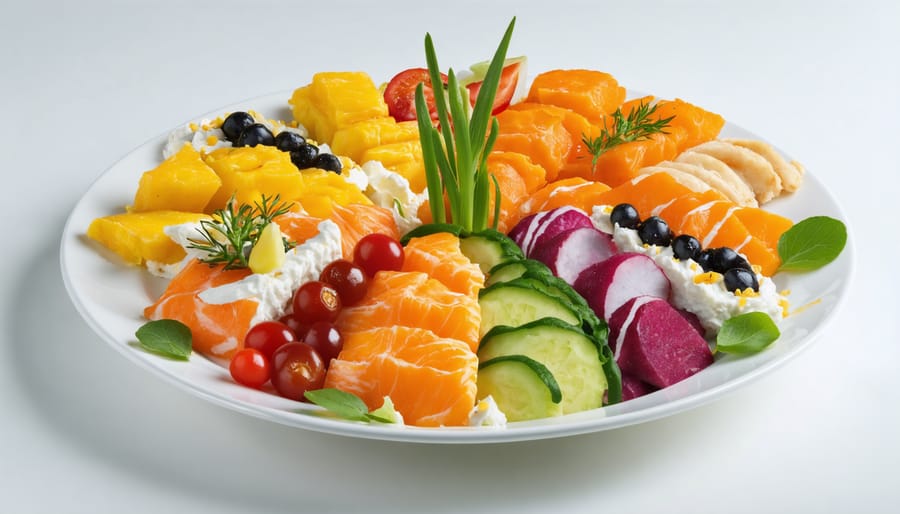
Imagine waking up each morning feeling genuinely content, not just going through the motions. True happiness isn’t a destination—it’s a mindful journey that begins with small, intentional choices. By learning to transform your relationship with food and daily habits, you’re already taking the first step toward lasting joy.
The path to happiness doesn’t require dramatic life changes or complex philosophies. Instead, it starts with simple, conscious decisions that ripple through every aspect of your life. Whether you’re dealing with workplace stress, relationship challenges, or simply seeking more meaning in your daily routine, these eight mindful steps will guide you toward authentic happiness—one moment at a time.
In this guide, we’ll explore practical, science-backed strategies that fit seamlessly into your busy life. These aren’t just feel-good tips; they’re transformative practices that have helped countless women discover their path to genuine contentment. Ready to begin your journey to a more fulfilled, balanced life? Let’s dive into the eight mindful steps that will help you cultivate lasting happiness.
The Power of Present-Moment Awareness
Creating Your Mindful Eating Space
Creating a peaceful eating environment can transform your meals from rushed moments to mindful experiences. Start by designating a specific spot in your home for meals – ideally a clean, clutter-free table away from your workspace. I learned this lesson after realizing how many times I’d mindlessly eaten lunch while answering emails!
Keep your dining area simple and inviting with minimal decorations. A small vase of flowers or a calming centerpiece can help set the mood. Turn off your phone notifications and step away from screens – this includes that tempting Netflix show! Instead, try playing soft background music or enjoying the natural sounds around you.
Set your table thoughtfully with nice plates and utensils – it’s amazing how using your “special” dishes can elevate an ordinary meal into a more meaningful experience. Remember, this space should feel like a peaceful retreat where you can truly focus on nourishing both body and soul.

Listen to Your Body’s Wisdom
The Hunger-Fullness Scale
Have you ever noticed how your body speaks to you throughout the day? The hunger-fullness scale is your body’s natural way of communicating when you need nourishment and when you’ve had enough. Think of it as a scale from 1 (absolutely starving) to 10 (uncomfortably full). Learning to recognize these signals can help you avoid both under-eating and overeating, especially when dealing with emotional eating triggers.
Start by checking in with your body before, during, and after meals. Aim to begin eating when you’re at a 3 or 4 (slightly hungry but not ravenous) and stop at a 6 or 7 (satisfied but not stuffed). It might take practice, but tuning into these subtle cues can transform your relationship with food. Remember, there’s no “perfect” way to eat – it’s about finding what feels right for your body and honoring those signals with compassion and awareness.

Engage Your Senses
The Five-Sense Food Exercise
Ever noticed how a meal tastes infinitely better when you’re fully present? The Five-Sense Food Exercise is your gateway to transforming everyday eating into a mindful experience. Choose a meal when you have at least 15 minutes of uninterrupted time. Before taking your first bite, observe the colors and presentation on your plate. Notice the steam rising from hot dishes or the glistening of olive oil on your salad.
Next, close your eyes and inhale deeply. What aromas can you identify? Listen to the sounds as you take your first bite – the crunch of fresh vegetables or the gentle tap of your utensils. As you eat, focus on the various textures and temperatures in your mouth. Is it creamy, crispy, or both? Finally, let the flavors dance on your tongue, noting how they change and develop.
This simple practice not only enhances your eating experience but also helps you develop a deeper appreciation for your food and the nourishment it provides.
Practice Gratitude for Your Food
Have you ever paused to consider the journey your morning coffee made before reaching your cup? From the farmers who cultivated the beans to the roasters who perfected their flavor, each meal tells a story of dedication and care. Taking a moment to appreciate this journey can transform your relationship with food and enhance your overall well-being.
Start by creating a pre-meal gratitude ritual. Before your first bite, take three deep breaths and silently acknowledge everyone involved in bringing that meal to your table. This simple practice helps ground you in the present moment and creates a deeper connection with your food.
I remember when I first started this practice, it completely changed how I approached my meals. Instead of mindlessly scrolling through my phone while eating lunch, I began noticing the colors, textures, and aromas of my food. This awareness naturally led to better food choices and more enjoyable dining experiences.
Try expressing your gratitude by supporting local farmers’ markets, learning about seasonal ingredients, or even growing your own herbs. When you understand the effort behind your food’s journey, every bite becomes more meaningful. Plus, this mindful approach often leads to more sustainable and conscious food choices, benefiting both your health and the environment.
Slow Down and Savor
Remember when you last truly savored a meal? I mean really savored it, letting each flavor dance on your tongue? In our fast-paced world, we often rush through meals without even tasting them. But slowing down while eating isn’t just about enjoying your food more – it’s a gateway to mindfulness and better health.
Start by setting the stage: put away your phone, turn off the TV, and create a peaceful dining environment. Take a moment to observe your food’s colors, textures, and aromas before taking your first bite. As you eat, try putting your fork down between bites and chewing each mouthful at least 20 times.
Here’s a little trick I learned: use your non-dominant hand to eat occasionally. It feels awkward at first, but it forces you to slow down naturally. Another helpful practice is to take three deep breaths before starting your meal – it signals to your body that it’s time to shift into a more relaxed state.
Pay attention to the subtle flavors that emerge as you chew. Notice how the texture changes, how the taste evolves. This isn’t just about eating slower; it’s about developing a deeper appreciation for your food and the nourishment it provides.

Choose Foods That Nourish
Nourishing your body isn’t just about counting calories or following strict diet rules – it’s about making mindful choices that serve both your physical and emotional well-being. Think of food as fuel for your vibrant life, choosing ingredients that make you feel energized, satisfied, and truly good from the inside out.
Start by tuning into your body’s signals. What foods give you sustained energy throughout the day? Which ones leave you feeling sluggish or uncomfortable? Building awareness around these responses helps you naturally gravitate toward choices that support your wellness goals.
Focus on incorporating whole, nutrient-rich foods that you genuinely enjoy. Maybe it’s the crunch of fresh vegetables, the warmth of homemade soup, or the sweetness of seasonal fruits. The key is finding healthy options that actually excite your taste buds. When you’re creating balanced meals, think colorful, varied, and satisfying rather than restrictive or boring.
Remember, nourishment isn’t just physical – it’s emotional too. Allow yourself to savor special treats mindfully, without guilt. The goal isn’t perfection but rather building a sustainable, joy-filled relationship with food that supports your overall happiness and well-being.
Release Food Judgment
Remember those moments when you’ve felt guilty about enjoying a slice of cake or labeled certain foods as “forbidden”? It’s time to break free from that cycle of food judgment. Just like we’re learning to be more compassionate with ourselves in other areas of life, we need to extend that same kindness to our relationship with food.
Start by noticing when you catch yourself thinking of foods as “good” or “bad.” These labels often create unnecessary stress and can lead to an unhealthy cycle of restriction and overindulgence. Instead, try viewing food through a lens of nourishment and enjoyment. All foods can have a place in a balanced lifestyle.
Think of it this way: that green smoothie might fuel your morning workout, while that homemade chocolate chip cookie connects you to cherished memories of baking with loved ones. Both serve different, equally valid purposes in your life.
Practice using neutral language when thinking or talking about food. Rather than saying “I’m being bad by eating this,” try “I’m choosing to enjoy this food right now.” This subtle shift in perspective can make a remarkable difference in your overall relationship with eating and self-image.
Remember, food is meant to be both nourishing and enjoyable. When we release judgment, we create space for a more peaceful, balanced approach to eating.
Build Sustainable Habits
Building sustainable habits is like planting a garden – it takes time, patience, and consistent care to see results. The key to making mindful eating a natural part of your daily routine lies in starting small and gradually expanding your practice. Instead of attempting a complete lifestyle overhaul, choose one mindful eating habit to focus on each week.
For example, you might begin by simply taking three deep breaths before each meal. Once that becomes second nature, add another practice, like putting your fork down between bites. Remember, sustainability comes from creating habits that fit your unique lifestyle and schedule.
I’ve found that keeping a mindful eating journal for the first few weeks can be incredibly helpful. Not only does it help track your progress, but it also reveals patterns in your eating behaviors that you might not have noticed before.
Create environmental triggers that remind you to eat mindfully. Maybe it’s a beautiful placemat that signals “mindful eating time” or a special corner in your home designated for meals. The goal isn’t perfection but progress – some days you’ll be more mindful than others, and that’s perfectly okay.
Consider finding an accountability partner or joining a mindful eating community. Sharing experiences and challenges with others who are on the same journey can provide motivation and support when your commitment wavers.
Embarking on your mindful eating journey is one of the most empowering decisions you can make for your overall well-being. By incorporating these eight steps into your daily routine, you’re not just changing how you eat – you’re transforming your entire relationship with food and yourself. Trust me, I’ve witnessed countless women in our community discover a newfound sense of peace and joy around mealtimes.
Remember, this isn’t about perfection; it’s about progress. Start small, perhaps with one mindful meal a day, and gradually build from there. You might notice improved digestion, better portion control, and even weight management naturally falling into place. But the real magic happens when you experience that wonderful moment of truly tasting and appreciating your food without judgment or guilt.
The journey to mindful eating is deeply personal, and every small step counts. Whether you’re dealing with busy schedules or family meals, these practices can adapt to fit your lifestyle. Why not start today? Your future self will thank you for taking this first step toward a more balanced, joyful relationship with food.



